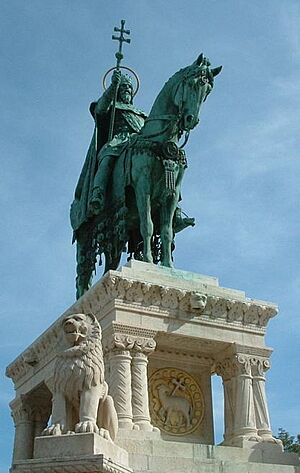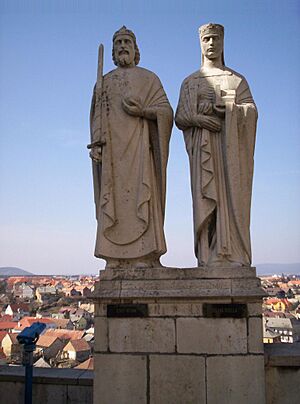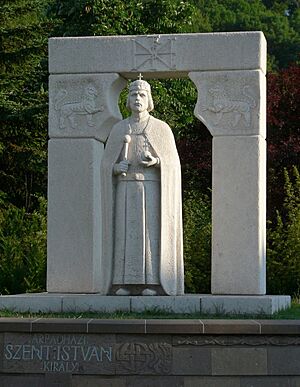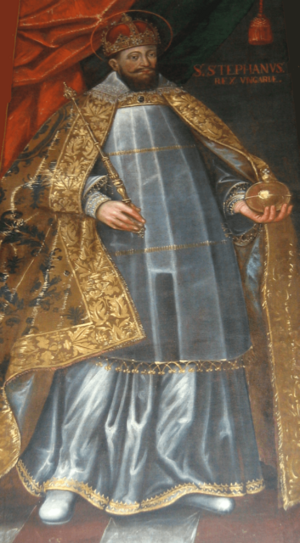Stephen I of Hungary facts for kids
Quick facts for kids Saint Stephen I |
|
|---|---|
| Apostolic King of Hungary | |
 |
|
| King of Hungary | |
| Reign | 1001–1038 |
| Coronation | 25 Dec. 1000 / 1 Jan. 1001 |
| Predecessor | Himself as Grand Prince |
| Successor | Peter I |
| Grand Prince of the Hungarians | |
| Reign | c. 997 – 1000 |
| Predecessor | Géza |
| Successor | Himself as King of Hungary |
| Born | ? 967 - 975 Esztergom, Principality of Hungary |
| Died | 15 August 1038 (aged 62-71) Esztergom or Székesfehérvár, Kingdom of Hungary |
| Burial | Székesfehérvár, Hungary |
| Spouse | Giselle of Bavaria |
| Issue | Saint Emeric |
| House | House of Árpád |
| Father | Géza of Hungary |
| Mother | Sarolt of Transylvania |
| Signature |  |
Saint Stephen I (Hungarian: I. (Szent) István) was born as Vajk in Esztergom, Hungary, sometime between 967 and 975. He became the Grand Prince of the Hungarians in 997. Later, in 1000, he became the very first King of Hungary.
Stephen is famous for making Hungary a strong Christian kingdom. He helped spread Christianity across the region. Many people see him as the founder of the modern Kingdom of Hungary. He was made a saint by Pope Gregory VII in 1083, along with his son, Saint Emeric of Hungary. In Hungary, August 20th is a special holiday that celebrates the founding of the state.
Contents
Stephen's Early Life

Stephen was born as Vajk in the town of Esztergom. His father was Géza of Hungary, the Grand Prince. His mother, Sarolt, came from Transylvania. She had been baptized into the Eastern Orthodox Church, but did not stay with that faith.
According to stories, Vajk was baptized as a Christian by Saint Adalbert of Prague. He was given the name Stephen (István). This name might have been chosen because it means "crown" or "standard." It also honored Saint Stephen, a major saint in Passau, where his future wife was from.
When Stephen was a teenager, his father, Prince Géza, decided that Stephen would be the next ruler. This was a new idea for the Hungarians. Usually, the oldest close relative of the ruler would take over.
Around 995, Stephen married Giselle of Bavaria. She was the daughter of Henry II, Duke of Bavaria. Giselle came to Hungary with German knights, which helped Stephen later on.
Becoming Prince and King
Taking Control of Hungary
In 997, Stephen's father died. There was a fight over who would rule next. Stephen believed he should rule by God's will, as a Christian king. But his uncle, Koppány, a powerful pagan leader, believed he should rule based on old tribal customs.
They fought a battle near Veszprém. Stephen won, thanks to his German knights. This victory helped him become the Grand Prince of the Hungarians. However, not all parts of Hungary accepted his rule right away.

Hungarian stories say that Pope Silvester II sent a beautiful crown to Stephen. This crown, along with a special cross, officially recognized Stephen as the Christian king of Hungary. This was seen as a sign that Hungary was independent from the Holy Roman Empire. Stephen was crowned king either on Christmas Day in 1000 or on January 1, 1001.
The Crown of St. Stephen is very important to Hungary. It is believed that Stephen dedicated the crown to the Holy Virgin Mary. This created a special bond between God and the crown, making it a "holy" crown. The actual crown we see today was likely made later, in the 12th century.
Hungary's First King

After becoming king, Stephen set up many important church areas called dioceses. He created dioceses in places like Veszprém, Győr, and Kalocsa. He also established the main church area in Esztergom. This helped create a church system in Hungary that was separate from German control. He also started organizing the country into counties, which helped with governing.
Stephen wanted to make Christianity strong in Hungary. He passed laws that made every ten villages build a church. He invited priests from other countries to help teach people about Christianity. Saint Astricus was his advisor, and Saint Gerard Sagredo taught his son, Saint Emeric of Hungary.
Around 1003, Stephen took control of Transylvania, which was ruled by his uncle, Gyula. After this, he set up another diocese there. He also took over lands in southern Hungary and established the Diocese of Pécs. He made agreements with other leaders, like Samuel Aba, who married Stephen's sister. Stephen also founded the Diocese of Eger in Samuel's lands.
Finally, Stephen took control of the lands of Ajtony, another pagan leader. There, he created the Diocese of Csanád.
Stephen's Foreign Policy

King Stephen worked with other countries to protect Hungary. He teamed up with his brother-in-law, Emperor Henry II, against Prince Boleslaw I of Poland. Boleslaw had taken over some lands near the Morava and Váh Rivers. Stephen sent his soldiers to help the emperor. In 1018, Boleslaw had to give those lands back to Stephen.
Stephen also sent troops to help Boleslaw I in a fight against Kievan Rus'. In 1018, Stephen led his own army against Bulgaria. He worked with the Byzantine Emperor Basil II and collected many holy items during this campaign.
After Emperor Henry II died in 1024, Stephen's relationship with the German Empire changed. The new emperor, Conrad II, wanted to control Hungary. Stephen, however, wanted the Duchy of Bavaria for his son Emeric. In 1027, Stephen even arrested an envoy sent by Conrad II. In 1030, Emperor Conrad II attacked Hungary, but Stephen's army forced him to retreat. They made peace in 1031, and some lands were given to Hungary.
Stephen's Later Years
Stephen had hoped to retire and let his son, Emeric, rule. But in 1031, Emeric died in a hunting accident. Stephen was very sad and his health suffered. He said that God took his son early so that "wickedness would not change his soul."
Since he had no other children, Stephen struggled to find someone to rule Hungary who would also keep the Christian faith strong. He did not trust his cousin, Duke Vazul, because he thought Vazul still followed pagan customs. Vazul tried to kill Stephen, but the plan failed. Vazul was punished by having his eyes removed and molten lead poured into his ears.
Without a clear heir, Stephen prayed to the Blessed Virgin Mary on his deathbed. He asked her to protect the Hungarian people and become their queen. King Stephen died on August 15, 1038, in Esztergom or Székesfehérvár, where he was buried. People mourned him for three years.
Stephen's Lasting Impact
After Stephen's death, there was a period of instability. His nephew, Peter Urseolo, and his brother-in-law, Samuel Aba, fought for the crown. Nine years later, Stephen's cousin Andrew I became king in 1047, bringing back stability to the Árpád family rule.
Soon after Stephen died, people reported healing miracles at his tomb. In 1083, Pope Gregory VII made Stephen a saint. His son, Saint Emeric of Hungary, and Bishop Gerhard were also made saints at the same time. Saint Stephen is now the patron saint of Hungary, kings, and children who are dying.
His feast day is celebrated on August 16th in the Catholic Church. In Hungary, it's celebrated on August 20th, the day his holy remains were moved to Buda. This day is a national holiday in Hungary.
The king's right hand, known as the Holy Right, is a very important relic. Hungarians believe that it did not decay after his death. This is seen as a sign that the Blessed Virgin Mary accepted Stephen's offer to make her the Queen of the Hungarians. The Holy Right is now kept in Saint Stephen's Basilica in Budapest. Hungarian Catholics have yearly processions where the Holy Right is shown.
In 2000, the Ecumenical Patriarch Bartholomew I of Constantinople also recognized Saint Stephen as a saint.
The Crown of St. Stephen, often linked to him, was taken out of Hungary in 1945 for safety. It was kept in the United States until 1978, when President Jimmy Carter returned it to Hungary. Since 2000, it has been displayed in the Hungarian Parliament building in Budapest.
Stephen in Art and Music

King Stephen of Hungary has been a popular subject in art, especially since the 1800s. Paintings like The Baptism of Vajk by Gyula Benczúr and many statues across Hungary show how important Stephen is to Hungarian national identity.
His story has also inspired music. The Hungarian composer Ferenc Erkel wrote an opera called István király (King Stephen) in 1885. More recently, the 1983 rock opera István, a király (Stephen, the King) by Levente Szörényi and János Bródy is very well-known. Ludwig van Beethoven also composed the King Stephen Overture.
Images for kids
-
King Saint Stephen's modern sculpture in Budapest
-
Modern statute of Bishop Gerard of Csanád and his disciple, Prince Emeric (both were canonized along with King Stephen in 1083). Püspökkút-statue in Székesfehérvár, installment
-
King Stephen at the funeral of his son, Saint Emeric
See also
 In Spanish: Esteban I de Hungría para niños
In Spanish: Esteban I de Hungría para niños




